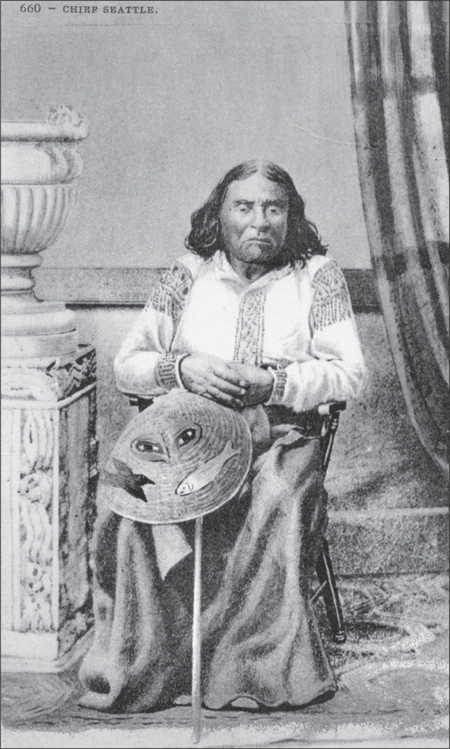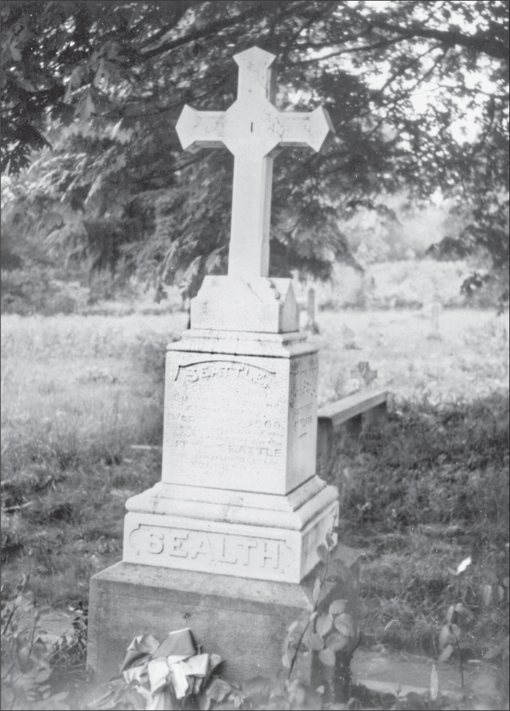
Native Americans first inhabited the land of Puget Sound. In a treaty of Port Elliott in 1855, Chief Sealth (Seattle) spoke of the differences regarding death:
To us the ashes of our ancestors are sacred and their resting place is hallowed ground. You wander far from the graves of your ancestors and seemingly without regret. Your religion was written upon tablets of stone by the iron finger of your God so that you could not forget. The Red Man could not comprehend nor remember it. Our religion is the traditions of our ancestors—the dreams of our old men, given to them in solemn hours of night by the Great Spirit; and the visions of our sachems, and is written in the hearts of our people.
Your dead cease to love you and the land of their nativity as soon as they pass the portals of the tomb and wander way beyond the stars. They are soon forgotten and never return. Our dead never forget the beautiful world that gave them being. They still love its verdant valleys, its murmuring rivers, its magnificent mountains, sequestered vales and verdant lined lakes and bays, and ever yearn in tender, fond affection over the lonely hearted living, and often return from the Happy Hunting Ground to visit, guide, console and comfort them.
Let him be just and deal kindly with my people, for the dead are not powerless. Dead, did I say? There is no death, only a change of worlds.
Native American remains, traditionally, were not left alone until the time of the spirit to make the journey to the happy hunting ground. New moccasins were provided, and on the morning of the service, the bodies of the deceased were washed like newborn babies. Usually they were dressed in their best clothes. After a wake, the deceased were buried with all that they owned.
Both cremation and burials were common for Native Americans. If a member of the tribe died while away from the tribe’s home area, then a cremation would take place to ensure that no physical portions of the body were left behind for an enemy to make “bad medicine” with or to interfere with the spirit journey.
Most commonly, ground burials took place in a shallow grave with slabs of cedar over the grave serving as a sort of roof. In some burials, the body was wrapped in rush mats that were laid in the ground and covered by a canoe.
The Denny party landed at Alki Point on November 13, 1851. The first known cemetery in the city of Seattle was on the land of the Denny Hotel at Second and Pine or Second and Stewart from around 1853 to 1860. An 1878 directory claimed that there were about 20 burials at this site. Most were removed and reburied.
The next known burial site was at the first church of Seattle, the Old “White Church,” which was Methodist and was founded by the Reverend and Mrs. Daniel Bagley. Next to the church was a graveyard at the corner of Second and Columbia. In 1856, two young men who were killed during the short Indian War were buried here.
There were also burials in the old tide flats at Maynard’s Point. In 1854, a Dr. W. B. G. Cherry was buried there when he died from wounds he received while part of a posse at Holmes Harbor. The few bodies that had been buried there were removed in September 1864.
Other burial sites were probably around the city, but with the passage of time they were forgotten. With Seattle becoming a boomtown, the Seattle Cemetery on Depot Street (now Denny Way) was started about 1861 on land donated by David Denny.
In 1864, bodies were removed from the Maynard and Arthur Denny’s claims and moved to the Seattle Cemetery. In 1875, John Denny (father of Arthur and David Denny) was buried at the Seattle Cemetery.
On January 3, 1873, a Seattle ordinance made the Seattle Cemetery official, with plots to be sold for no less than $10 each. The mayor at that time was to appraise the lots. The Seattle City Council was to appoint a city sexton who would be in charge of the cemetery. The sexton was to keep track of all sold and empty lots, be in charge of burials, keep the cemetery clean, sell the lots, keep all records, arrest anyone breaking the law in the cemetery, and appoint his own successor.
Ordinance No. 346 passed in January 1883, requiring both birth and death certificates.
During the gold rush of the late 19th century, many men with gold-lined pockets were robbed and killed on the streets of Seattle and then dumped into Elliott Bay. King County offered $50 to any funeral director who would pick up and dispose of these bodies properly. One can imagine several funeral coaches racing down the hilly streets of Seattle, rushing to be first to collect the body.
In 1870 or 1871, on land at the top of Capital Hill belonging to Dr. Maynard, a new cemetery named Lake View was born. Lyman Bonney, Dr. Maynard, and C. C. Shorey formed the Seattle Masonic Cemetery Association, which was related to the Masons in name only. An April 26, 1873, article in the Weekly Intelligencer described this new cemetery: “Turning to the west, we see the vast expanse of Puget Sound, with its bold headlands, one above another, and beyond them the rugged, craggy peaks of Olympus and the Coast Range sharply outlined against the sky. Without doubt, the Association selected the most fitting location for the ‘City of the Dead.’ ”
On May 9, 1873, Mrs. L. P. Smith was buried at Lake View Cemetery. Doc Maynard was buried on May 10. A total of 237 plots were filled by 1878, mostly as reburials from other cemeteries. Another huge part of this cemetery was set aside for Chinese burials.
During the late 1800s, Duwamish Cemetery came into being in west Seattle, with burials of the poor and from county hospital.
In February 1884, bodies were removed from the old Seattle Cemetery so it could be turned into a public park, and the 223 bodies were dug up and reburied at the Masonic cemetery (Lake View), the new municipal cemetery (currently Volunteer Park), the new Catholic burial ground, Washelli (Evergreen-Washelli), Oak Lake and Mount Pleasant. The City of Seattle paid O. C. Shorey $3,000 to make new cedar boxes and to exhume and rebury the dead. During the regrading of Denny Hill, some missed burial plots became apparent; in the midnight hour, they were quietly removed and reburied. Legend has it that this is where the term “graveyard shift” comes from.
First Washelli Cemetery was the new municipal cemetery (currently Volunteer Park) on top of Capital Hill, built on 40 acres bought by Seattle in 1876 for $2,000.
I hope that you enjoy these photographs as much as I have and that you learn something about our Seattle history. This is my view of history, and I am sure that if someone else were to assemble a pictorial book on the subject it would have a different view. Enjoy!

CHIEF SEATTLE. Taken by E. M. Sammis, Seattle’s first photographer, only this one photograph exists of Chief Sealth (Seattle). Sealth was studying portraits of settlers displayed in the photographer’s window when Sammis motioned the chief inside. The original image features Sealth with his eyes closed. Doctored copies show his eyes open, as in the postcard pictured here. (Courtesy Cherian Thomas Photography.)

CHIEF SEALTH MEMORIAL. Sealth was born in 1786 and was given the Lushootseed-language name “Si?al.” Early pioneers gave him the name Seattle because they could not pronounce his name. Sealth died in 1866. His grave lies in a small cemetery behind the St. Peter’s Catholic Church on Washington’s Kitsap Peninsula.